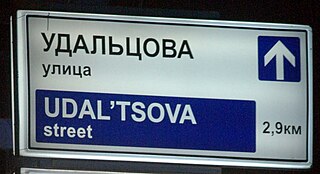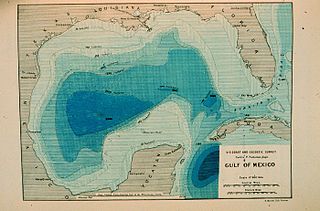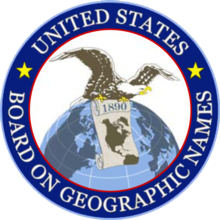
In linguistics, Romanization or romanisation is the conversion of text from a different writing system to the Roman (Latin) script, or a system for doing so. Methods of romanization include transliteration, for representing written text, and transcription, for representing the spoken word, and combinations of both. Transcription methods can be subdivided into phonemic transcription, which records the phonemes or units of semantic meaning in speech, and more strict phonetic transcription, which records speech sounds with precision.

The Geographic Names Information System (GNIS) is a database of name and location information about more than two million physical and cultural features throughout the United States and its territories; the associated states of the Marshall Islands, Federated States of Micronesia, and Palau; and Antarctica. It is a type of gazetteer. It was developed by the United States Geological Survey (USGS) in cooperation with the United States Board on Geographic Names (BGN) to promote the standardization of feature names.

The romanization of the Russian language, aside from its primary use for including Russian names and words in text written in a Latin alphabet, is also essential for computer users to input Russian text who either do not have a keyboard or word processor set up for inputting Cyrillic, or else are not capable of typing rapidly using a native Russian keyboard layout (JCUKEN). In the latter case, they would type using a system of transliteration fitted for their keyboard layout, such as for English QWERTY keyboards, and then use an automated tool to convert the text into Cyrillic.
The romanization of Ukrainian, or Latinization of Ukrainian, is the representation of the Ukrainian language in Latin letters. Ukrainian is natively written in its own Ukrainian alphabet, which is based on the Cyrillic script. Romanization may be employed to represent Ukrainian text or pronunciation for non-Ukrainian readers, on computer systems that cannot reproduce Cyrillic characters, or for typists who are not familiar with the Ukrainian keyboard layout. Methods of romanization include transliteration and transcription.

The Ukrainian Latin alphabet is the form of the Latin script used for writing, transliteration and retransliteration of Ukrainian.
The GEOnet Names Server (GNS), sometimes also referred to in official documentation as Geographic Names Data or geonames in domain and email addresses, is a service that provides access to the United States National Geospatial-Intelligence Agency's (NGA) and the US Board on Geographic Names's (BGN) database of geographic feature names and locations for locations outside the US. The database is the official repository for the US Federal Government on foreign place-name decisions approved by the BGN. Approximately 20,000 of the database's features are updated monthly. Names are not deleted from the database, "except in cases of obvious duplication". The database contains search aids such as spelling variations and non-Roman script spellings in addition to its primary information about location, administrative division, and quality. The accuracy of the database had been criticised.
The romanization of Khmer is a representation of the Khmer (Cambodian) language using letters of the Latin alphabet. This is most commonly done with Khmer proper nouns, such as names of people and geographical names, as in a gazetteer.

The Sigsbee Deep, is a roughly triangular basin that is the deepest part of the Gulf of Mexico named for Commander Charles Dwight Sigsbee, USN, and Assistant, United States Coast and Geodetic Survey, commanding officer of USC&GS George S. Blake, which discovered the feature during its mapping of the Gulf of Mexico. As described below there is some confusion of names that apply to the basin or a particular point in the basin with both being found in technical and popular literature applying to both basin and the coordinates.
Romanization or Latinization of Belarusian is any system for transliterating written Belarusian from Cyrillic to the Latin alphabet.
BGN/PCGN romanization are the systems for romanization and Roman-script spelling conventions adopted by the United States Board on Geographic Names (BGN) and the Permanent Committee on Geographical Names for British Official Use (PCGN).
BGN/PCGN romanization system for Russian is a method for romanization of Cyrillic Russian texts, that is, their transliteration into the Latin alphabet as used in the English language.

The name of the city of Pittsburgh, Pennsylvania, has a complicated history. Pittsburgh is one of the few U.S. cities or towns to be spelled with an h at the end of a burg suffix, although the spelling Pittsburg was acceptable for many years and was even held as standard by the federal government from 1891 to 1911.
The BGN/PCGN romanization system for Belarusian is a method for romanization of Cyrillic Belarusian texts, that is, their transliteration into the Latin alphabet.

The Antarctic Place-names Commission was established by the Bulgarian Antarctic Institute in 1994, and since 2001 has been a body affiliated with the Ministry of Foreign Affairs of Bulgaria.
The Permanent Committee on Geographical Names (PCGN) is an independent inter-departmental body in the United Kingdom established in 1919. Its function is to establish standard names for places outside the UK, for the use of the British government. The Committee has collaborated with the Foreign Names Committee of the United States Board on Geographic Names to agree a joint romanization system, first published in 1994 as the Romanization Systems and Roman-Script Spelling Conventions.
Bindschadler Ice Stream is an ice stream between Siple Dome and MacAyeal Ice Stream. It is one of several major ice streams draining from Marie Byrd Land into the Ross Ice Shelf. The ice streams were investigated and mapped by U.S. Antarctic Research Program personnel in a number of field seasons from 1983 to 1984 and named Ice Stream A, B, C, etc., according to their position from south to north.
BGN/PCGN romanization system for Kazakh is a method for romanization of Cyrillic Kazakh texts, that is, their transliteration into the Latin alphabet as used in the English language.
BGN/PCGN romanization system for Kyrgyz is a method for romanization of Cyrillic Kyrgyz texts, that is, their transliteration into the Latin alphabet as used in the English language.
Romanization of the Burmese alphabet is representation of the Burmese language or Burmese names in the Latin alphabet.
Wolfgang Louis Gottfried Joerg, better known as W. L. G. Joerg, was an American geographer, and in particular an expert in the geography of the Arctic and Antarctic regions, who exercised broad influence on the field in various positions, ultimately as Chief Archivist of the Cartographic Records Branch of the National Archives.







